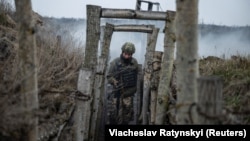KYIV -- Before dawn on July 16, Vladyslav woke up in his car. At 4:37 a.m., he was fourth in a line at a draft office in Ukraine’s capital.
It was the last day for men eligible for military service to register or update their personal details with the military.
“I was here several times before and lost many hours,” Vladyslav, who did not want his last name published, told RFE/RL. “In the end, I had to sleep in the car, parked nearby, to make it on time.”
As Russia’s full-scale invasion grinds on in its third year, with Moscow’s forces exerting enormous pressure on often exhausted soldiers on multiple sections of the 1,200- kilometer front line in the east and south, Ukraine is struggling to increase the number of troops available for its defense.
A controversial mobilization law, adopted in April after heated debate, took effect in May.
July 16 marked the end of a 60-day grace period during which all citizens eligible for mobilization were required to update their personal data at military-run territorial recruitment centers or civilian administrative centers -- or via a newly rolled out government app, Reserve+.
Vladyslav was one of some 4 million citizens who renewed their data by the deadline, according to the Defense Ministry, including 2.7 million who did so through the app.
For weeks, draft offices were struggling with crowds of conscripts trying to fulfill their duty, lining up for hours in the sweltering summer heat. Blackouts -- a result of Russia’s relentless attacks on Ukraine’s power infrastructure – added to the troubles.
Some of those who complied with the law will now receive a summons and head to military medical commissions for examinations to determine their fitness for service. Others will get exemptions on various grounds.
'Trying To Hide'
Those who did not comply face fines and other civil restrictions such as the potential revocation of driver's licenses or, in the case of military-age men abroad, the right to consular services.
“From now on, they can also receive a summons by post, which will be treated as delivered even without their confirmation of receipt,” Deputy Defense Minister Kateryna Chernohorenko told RFE/RL.
If they ignore this, they can be declared wanted within a criminal proceeding.
“Some people are trying to hide their data, but it is a matter of time -- all citizens [subject to mobilization] will be in the military register,” Serhiy Starenkiy, deputy chairman of the Human Rights Protection Committee of the Ukrainian National Bar Association, told RFE/RL.
Ukraine introduced these procedures to make identifying men eligible for conscription easier and mobilizing them more efficient.
Prior to the new legislation, the bulk of summonses had been handed out to men by military patrols on the streets of cities, towns, and villages. That practice has provoked controversy, and there have been numerous reports of violence used by or against draft officers across Ukraine.
In one such case, 32-year-old Serhiy Kovalchuk died in the hospital after a visit to a draft office in the Zhytomyr region. Recruiters attributed his death to an epileptic seizure and alcohol, but the death certificate indicated that the cause was multiple cranial-cerebral injuries with displaced skull bones.
Kovalchuk’s family alleges that he was assaulted at the draft office, and over 100 people staged a protest outside the building over the incident.
Thousands of men have fled or left the country -- which is illegal for men of fighting age under martial law, in effect since shortly after Russia launched the full-scale invasion in February 2022 -- and others have gone into hiding or use legal loopholes to try to avoid the draft.
Some Ukrainians soured on recruitment efforts due to widespread reports of corruption in draft offices. Last August, President Volodymyr Zelenskiy dismissed the senior military recruiter in each of Ukraine’s regions as reports of corruption proliferated.
The push to bolster the military ranks comes as the enthusiasm to serve that marked the early months of the full-scale Russian invasion has faded.
In a late June poll conducted by the Kyiv-based Razumkov Center, about 46 percent of respondents said there is no shame in being a draft dodger, while 29 percent held the opposite opinion, and 25 percent found it difficult to answer.
Still, the government asserts that the stepped-up mobilization campaign is going well.
“The military says that everything is going according to their plan,” Zelensky said at a press conference on July 15, adding that there are not enough training grounds and that the state is working to expand them.
Prisoners And More
Shortly before the mobilization law was adopted, Zelenskiy signed a bill lowering the lower end of the age range in which men can be drafted from 27 to 25, leaving the upper limit at 60, and ordered those who previously held "partially eligible" status to go through mandatory medical checks.
Some men aged 18-24 can also be called up, and women can volunteer to serve.
In another bid to recruit more troops, Kyiv has also allowed some categories of prisoners to serve in the military.
Meanwhile, some of the most popular units -- such as the Third Separate Assault Brigade, the 93rd Mechanized Brigade, and the Khartia Brigade -- opened their recruitment centers and are running marketing campaigns, leaving Ukrainian cities plastered with billboards with calls to join the army.
Military and civilian critics of the mobilization law note that it fails to address the questions of rotation -- giving units a chance to rest, away from frontline fighting -- and demobilization, when an active-duty soldier can legally leave service.
“If this [current] trend continues into the fall, it may then be possible to submit a bill on demobilization to the Verkhovna Rada,” Roman Kostenko, head of the parliament’s National Security Committee, said in June.
Separately, in an interview with a German newspaper, Kostenko said that the Ukrainian military could enlist 200,000 additional troops by the end of the year.
Former top General Valeriy Zaluzhniy’s reported request for 500,000 new recruits was believed to be one of the reasons Zelenskiy dismissed him in February.
There are 4.35 million Ukrainian men who are eligible for service and are not yet in the military, according to Dmytro Natalukha, chairman of the Economy Committee in parliament. Some estimates put the number higher.
Ukrainian officials have said on different occasions that their armed forces number from 800,000 to 1 million. In February, Zelenskiy said that 31,000 soldiers had been killed since February 2022, a figure seen as a major undercount.




